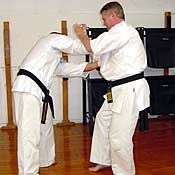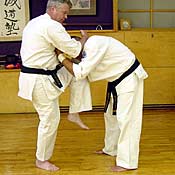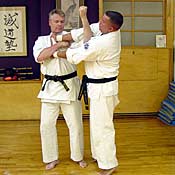The Straight Arm Double Lapel Grab, Part 2
By Christopher Caile

Introduction
This article is a continuation to the first part of this series, “The Straight Arm Double Lapel Grab, Part 1.” Both articles address the situation where an attacker grabs the jacket lapel or shirt on both sides, but then holds the defender at arm’s length. Part 1 shows a defense to this attack taken from the karate kata Pinan number four. Part 2 features a second self-defense technique to the same attack taken from another kata. These articles complement an earlier article, “The Double Lapel Grab,” which addressed the same grab, but there the attacker pulled the defender in.
A double lapel grab is not much of an attack. As discussed in Part 1, it is a somewhat timed attack and often indicates that the attacker really doesn’t want to get into an all out conflict, or isn’t sure what to do. Of course, if this attack is but a prelude to a kick, or a controlling method to set you up for a follow up strike, then it is more serious. Thus, you always have to be attentive.
In this article we will assume that you, the defender, have already tried (see Part 1) to diffuse the situation verbally, or did nothing and the situation eventually diffused itself. You might have also escalated your measures and tried a painful, but not aggressive, pinch to the underside of the attacker’s extended arms to make him or her let go.
In any self-defense situation, if you can, it is best to proceed through a “continuum of force,” escalating only as far as necessary to protect yourself. These include:
• Non-Reaction (if applicable).
• Verbal diffusion.
• Physical techniques which may hurt or sting to create the release itself, but will not harm the aggressor.
• Strikes, kicks, or joint manipulations and other measures to free yourself and/or control or immobilize.
• Techniques to render the assailant unconscious or incapacitated.
The Defense
Part 1 of this two-part series illustrated self-defenses technique against the straight arm double lapel grab taken out of Pinan 4. It involved stepping back or forward with one leg (depending on the action of the attacker), driving your arms up between the attacker’s outstretched grabbing arms and then kicking the opponent with the rear leg. This technique illustrates one of two good solutions to this attack – a kick.(1) A kick is used because if the defender is significantly smaller and shorter than the attacker, the defender’s arm reach is too short to hit the face or head of the attacker.
Follow-up techniques always depend on the attacker’s reaction. In the example given in Part 1 of this series, the attacker let loose of one arm enabling the defender to follow up with a double punch to the opponent’s head. A different reaction could have just as easily led to a second or third kick, or a follow up elbow to the head or other technique.
This article (Part 2) illustrates another solution taken from the kata Seienchin. This technique series can be used alone, or be linked to that shown in Part 1, as a follow up technique if, after kicking the attacker, he or she still has hold of your shirt or jacket with both hands.
In Seienchin kata, the defender places his arm (here, the right) across his or her chest, over the attacker’s left outstretched arm and under the attacker’s right. The fist, now at the defender’s left side at about solar plexus level, is then supported by a left open hand.


To make this technique work, however, the attacker’s arms need to be straight. To insure this situation I prefer to add a right hand slap to the opponent’s face (not seen in the kata) as I am bringing my right arm across. The opponent’s natural reaction is to push his or her arms out as a defensive reaction to avoid being hit. Thus, even if the defender’s arms are too short to make contact, the attacker’s reaction will be the same.
Another technique is to execute a middle front kick (which has greater range) to the opponent. This will have similar effect. It is also indicated as a possible move within the kata since in the kata, the defender’s foot position is a cat stance (one leg pulled back, the heel raised as if ready to kick).
The Primary Technique
This article (Part 2 of the series) illustrates a second viable solution to this attack – forcibly rotating (using leverage) the attacker’s arms into a position so that one is above the other, which not only unbalances the opponent to the side, but allows the defender to move around the attacker’s outstretched arms to attack the body, head or limbs of the attacker.
 Here the defender raises his right fist (elbow down close to the body), supported by his left, in a circular movement upward while also moving his whole body to the right 45 degrees.(2) The effect is to pry the opponent’s right arm upward almost over his left, unbalance him to the left and slightly forward, while also putting his weight onto his left leg. The attacker is now in a very vulnerable position and might just let go. If so, you would have to decide whether just to walk away or continue to counter attack depending on the situation.
Here the defender raises his right fist (elbow down close to the body), supported by his left, in a circular movement upward while also moving his whole body to the right 45 degrees.(2) The effect is to pry the opponent’s right arm upward almost over his left, unbalance him to the left and slightly forward, while also putting his weight onto his left leg. The attacker is now in a very vulnerable position and might just let go. If so, you would have to decide whether just to walk away or continue to counter attack depending on the situation.
The weakness that this technique exploits is the fact that extended arms have little power or ability to resist side to side manipulations. They may be strong in a push or pull, and are hard to bend, but straight and extended they have little strength to the sides or up and down. This weakness is increased when the defender, while turning to the right, also slightly pulls the attacker’s arms forward creating further unbalance.(3)
Secondary, Follow-up Techniques
In any self-defense situation the defender’s primary self-defense technique opens up possibilities for secondary or follow-up techniques. These may vary depending on how the attacker reacts. Some follow-up techniques may preclude others, while others may be used together. Thus in analyzing kata pay greatest attention to primary techniques while realizing that any secondary techniques may have to be varied or not used at all if the attacker reacts differently than expected.(4) For example, the kata suggests a possible kick into the attacker’s left leg once the right arm has been pried up (5), but this only works if the defender doesn’t pivot with his legs. It also precludes the other follow up techniques included within the kata.
Now let’s look again at the opponent where we left him. He has been off-balanced to the side and slightly forward, his weight is on his left leg, and his right arm has been moved above his left. Two opportunities immediately present themselves.
 Follow-up Option 1 — The simplest technique is just to step (or drop) forward with the left foot into a straddle or horse stance while pivoting the body to do a left fist downward strike into the opponent’s groin, while your right hand grips the opponent’s right arm, ideally holding it across the body so the elbow is locked pressed against your own center. If you can get this arm lock against the opponent’s elbow, you can easily break it (requires a subtle body shift). If the elbow instead bends, you at least have control of the attacker’s arm while you strike.(6)
Follow-up Option 1 — The simplest technique is just to step (or drop) forward with the left foot into a straddle or horse stance while pivoting the body to do a left fist downward strike into the opponent’s groin, while your right hand grips the opponent’s right arm, ideally holding it across the body so the elbow is locked pressed against your own center. If you can get this arm lock against the opponent’s elbow, you can easily break it (requires a subtle body shift). If the elbow instead bends, you at least have control of the attacker’s arm while you strike.(6)
 The kata also suggests a second follow-up technique to the groin strike shown above. The next movement in the kata is to withdraw the left leg to the rear into a horse or straddle stance facing the opposite direction. While beginning this move the right arm is raised in preparation for executing a right lower block or strike while the left arm is extended downward.
The kata also suggests a second follow-up technique to the groin strike shown above. The next movement in the kata is to withdraw the left leg to the rear into a horse or straddle stance facing the opposite direction. While beginning this move the right arm is raised in preparation for executing a right lower block or strike while the left arm is extended downward.
In reality this movement breaks down as follows. The right arm that moves upward and across the body is executed as the left leg is withdrawn. The middle of this technique has the action. A hidden move in the kata is that as you begin to shift backwards, the withdrawn left leg rises into a knee strike to the opponent’s face (already lowered in reaction to the arms being pried to the side and forward, and more so following the groin strike), while at the same time your right arm hits inward toward yourself to the back of the opponent’s head. This can have a devastating effect.

The left leg is then withdrawn into a horse stance, as your left arm pushes down on the opponent’s head, right arm raised. You can then perform a right downward strike to the neck or side of the head.
Follow-up Option 2 – Let’s go back to the position where you have leveraged the opponent’s right arm above his left. Look at the photo:


You will notice that the opponent’s two arms present a sort of window through which your left arm can strike. In the kata the practitioner at this point raises his right arm in preparation for executing a left downward block. But this movement can contain a lot more. A little modification turns this movement into a devastating upper cut (through the window of the opponent’s outstretched arms), hitting the opponent under the jaw.
 This again might end it all there and the opponent might just collapse. At a minimum, you have created a tremendous distraction, and this affects the opponent’s arms. With attention on the strike and probably occupied by star bursts going off in his or her head, you can now slide your left arm into position to attack the elbow. Use the crook of your elbow to hit sharply upward against the upper arm while straightening your legs slightly as you simultaneously pull down with your right hand on the opponent’s wrist — another elbow attack.(7)
This again might end it all there and the opponent might just collapse. At a minimum, you have created a tremendous distraction, and this affects the opponent’s arms. With attention on the strike and probably occupied by star bursts going off in his or her head, you can now slide your left arm into position to attack the elbow. Use the crook of your elbow to hit sharply upward against the upper arm while straightening your legs slightly as you simultaneously pull down with your right hand on the opponent’s wrist — another elbow attack.(7)
After this you may, if necessary, continue the technique sequence as shown in “Follow-up Option 1,” above. The beauty of this technique sequence is that many options and opportunities are offered for follow-up techniques. The attacker will probably just let go at a number of points along the way during this series of techniques, but maybe not. You also have lots of options, some more forceful than others.
Footnotes:
(1) A number of other often taught self-defense measures to the double straight arms grab just don’t work. For example, some readers suggested using one arm to press down across the attacker’s two straight arms to bend them, while punching with the other hand to the face. This just doesn’t work. Aikido people often demonstrate how an almost straight arm is practically unbendable. Two arms are double the trouble. And if the defender is smaller and weaker – don’t even try.
(2) A common mistake made by many karate-ka is to move their upper body while doing this type of technique while keeping their feet in place. While this can work, it requires a lot more muscle. Ideally, when the right fist is raised, it should be kept near the center of the body while the whole body is turned. This way, the arm is kept near the center of the body which is its strongest position. It is for this reason that practitioners of aikido, diato-ryu and many jujutsu systems always keep their arms (when they are doing techniques) centered at their middle. It is the same position that Japanese swordsmen hold their swords as well as the finishing position for many karate blocks. This allows the defender’s turning body weight –and not just his arms — to do the strength work. Whenever the body’s shoulders are not over its hips, body strength can be lost when applying strength.
(3) This is done within the kata. By rotating the body 45 degrees, the defender is also slightly pulling the defender forward. This forward unbalancing movement can also be emphasized if another stance is used. The other day while getting ready for practice at our Seido karate headquarters in NYC, I saw one of the instructors, Angel Alicea, demonstrating a self-defense technique to beginning students that seemed to be the same technique illustrated here. Later that night I asked Angel about it and he mentioned that it was a technique he had developed. Only after mentioning the kata Seienchin did he make the connection. In his version, however, he added an interesting and effective variation. When he moved his arms up and over to pry to opponent’s right arm above his left, Angel didn’t just pivot 45 degrees to the right (as in the kata) but also stepped slightly back with his right foot (his feet were in a natural stance and not in the cat stance as in the kata) to pull the attacker forward and much more off-balance. This is an effective alternative. It also shows that good technique is created as often today as it was among the masters of the past. Moreover it shows that similar techniques may have been developed over and over again by countless generations of martial arts practitioners in earlier periods and in different areas of the world.
(4) Equally, an opponent may react differently depending on how the defender’s technique was executed. Thus while practicing self-defense techniques it is important to practice them over and over again with a variety of attackers whose size and strength vary. In this way, you can learn how people react and therefore learn how to perform the techniques correctly. You also learn alternatives, so when your technique is faulty or the opponent reacts differently, you have viable technical solutions.


(5) Here the defender kicks (right foot) to the inside of the opponent’s leg, just above the knee — a very sensitive and painful point which often results in the buckling of the leg. The kicking surface can be the ball of the foot, the flat underside of the foot, or as demonstrated here, using the toes. This kick strikes the femoral nerve that runs down the inside of the thigh. If the inside leg is struck just above the knee, the leg will often buckle, as illustrated here. The defender can then simply open his right fist and grasp the attacker’s right wrist and effect an arm lock on the opponent — thus executing one of the two horse stance down block combinations seen in the kata.
(6) If you want to attack the elbow, you have a second chance. Your left arm after striking down can be brought up inside the attacker’s left arm, your own arm hitting upward (as you also raise your body) as you pull down with your right arm on the attacker’s wrist. If done with snap and power, the combined impact of going in two directions can also break or injure the opponent’s elbow.
(7) This type of elbow break is very prevalent in many forms of Chinese combative arts that I have studied, including Praying Mantis and White Eyebrow (Pak Mei) Kung Fu.
Disclaimer: The techniques demonstrated here are for informational purposes only. Some of the techniques are extremely dangerous and should not be attempted or practiced unless under supervision of a trained karate exponent who also has knowledge of joint locks and other joint manipulations.

About the Author Christopher Caile

Christopher Caile
Christopher Caile is the Founder and Editor-In-Chief of FightingArts.com. He has been a student of the martial arts for over 65 years.
He first started in judo while in college. Then he added karate as a student of Phil Koeppel in 1959 studying Kempo and Wado-Ryu karate. He later added Shotokan Karate where he was promoted to brown belt and taught beginner classes. In 1960 while living in Finland, Caile introduced karate to that country and placed fourth in that nation’s first national judo tournament.
Wanting to further his karate studies, Caile then hitch hiked from Finland to Japan traveling through Scandinavia, Europe, North Africa, the Middle East and South and Southeast Asia — living on 25 cents a day and often sleeping outside.
Arriving in Japan (1962), Caile was introduced to Mas Oyama and his fledgling full contact Kyokushinkai Karate by Donn Draeger, the famous martial artist and historian. Donn also housed him with several other senior international judo practitioners. Donn became Caile’s martial arts mentor, coaching him in judo and introducing him to Shinto Muso-ryu under Takaji Shimizu.
Caile studied at Oyama’s honbu dojo and also at Kenji Kurosaki’s second Tokyo Kyokushinkai dojo. In his first day in class Oyama asked Caile to teach English to his chief instructor, Tadashi Nakamura. They have been friends ever since. Caile also participated in Oyama’s masterwork book, “This Is Karate.”
Caile left Japan with his black belt and designation as Branch Chief, the first in the US to have had extensive training in Japan directly under Oyama Sensei. As such, Oyama Sensei asked him to be his representative on visits to his US dojos to report on their status.
A little over a year later, Nakamura, Kusosaki and Akio Fujihira won an epic David vs. Goliath challenge match against Thailand’s professional Muay Thai Boxers in Bangkok, Thailand, thrusting Kyolushinkai and Nakamura into national prominence.
Back in the US Caile taught Kyokushinkai karate in Peoria, Il while in college and later in Washington, DC. while in graduate school. Durimg this time Shihan Nakamura had moved to New York City to head Kyokushinkai’s North American Operation.
In 1976 when Kaicho Tadashi Nakamura formed the World Seido Karate organization, Caile followed. Living then in Buffalo, NY, Caile taught Seido karate and self-defense at the State University of New York at Buffalo (SUNY Buffalo) for over 15 years where he also frequently lectured on martial arts and Zen in courses on Japanese culture.
Caile moved to New York City in 1999 to marry Jackie Veit. He is now an 8th degree black belt, Hanshi, training in Seido Karate’s Westchester, NY Johshin Honzan (Spiritual Center) dojo. In Seido Caile is known for his teaching of and seminars on kata applications. He also produced a 14 segment video series on Pinan kata Bunkai currently available to Seido members.
Caile is also a long-time student and Shihan in Aikido. He studied in Buffalo, under Mike Hawley Shihan, and then under Wadokai Aikido’s founder, the late Roy Suenaka (uchi deshi under Morihei Ueshiba, founder of Aikido and was Shihan under Tohei Sensei). In karate, Suenaka (8thdan) was also an in-house student of the Okinawan karate master Hohan Soken.
Having moved to New York City, Caile in 2000 founded this martial arts educational website, FightingArts.com. Twenty-five years later, in 2025, it underwent a major update and revision.
For FightingArts.com and other publications Caile wrote hundreds of articles on karate, martial arts, Japanese art, Chinese Medicine and edited a book on Zen. He also developed relationships with a cross section of leading martial arts teachers. Over the last four decades he has conducted extensive private research into karate and martial arts including private translations of the once secret Okinawan hand copied and passed on Kung Fu book, the Bubishi, as well as an early karate book by the karate master Kenwa Mabuni. He periodically returns to Japan and Okinawa to continue his studies and participate Seido karate events. In Tokyo he practiced (with Roy Suenaka Sensei) in a variety of aikido organizations with their founders – including private interviews and practices at the Aiki-kai Aikido Honbu dojo with the son and grandson of aikido’s founder, Doshu (headmaster) Kisshomaru (an old uchi-deshi friend) and his son, Moriteru Ueshiba and in Iwama with Morihiro Saito. On Okinawa he studied Goju Ryu karate under Eiichi Miyazato, 10th dan founder of Naha’s Jundokan, and also with Yoshitaka Taira (who later formed his own organization, who specialized in kata Bunkai. While there Caile also trained with Hohan Soken’s senior student, Master Fusei Kise, 10 dan as well as with the grandson of the legendary karate master Anko Itosu.
Caile’s other martial arts experience includes: Diato-ryu Aikijujitsu and Kenjitsu, kobudo, boxing, Muay Thai, MMA, Kali (empty hand, knife and bolo), study of old Okinawan Shoran-ryu & Tomari body mechanics, study of old Okinawan kata under Richard Kim, study of close quarter defense and combat, including knife and gun defenses, Kyusho Jitsu and several Chinese fighting arts including 8 Star Praying Mantis, Pak Mei (White Eyebrow), and a private family system of Kung Fu.
Caile is also a student of Zen as well as a long-term student of one branch of Traditional Chinese Medicine, Chi Kung (Qigong). As one of two senior disciples of Chi Kung master Dr. Shen (M.D., Ph.D.) Caile was certified to teach and practice. This led to Caile’s founding of the The Chi Kung Healing Institute on Grand Island, NY. In Western NY, he also frequently held Chi Kung seminars, including at SUNY Buffalo and at the famous Chautauqua Institution in Chautauqua, NY. His articles on Chi Kung also appeared in the Holistic Health Journal and in several books on alternative medicine.
Caile holds a BA in International Studies from Bradley University and MA in International Relations with a specialty in South and Southeast Asia from American University in Washington, D.C. While in Buffalo, NY he also studied digital and analog electronics.
In his professional life Caile also worked in public relations and as a newspaper reporter and photographer. Earlier he worked in the field of telecommunications including Managing a Buffalo, NY sales and service branch for ITT. He then founded his own private telephone company. This was followed by creation of an electrical engineering company that designed and patented his concept for a new type of low-cost small business telephone system (which was eventually sold to Bell South). The company also did contract work for Kodak and the US space program. Simultaneously Caile designed and manufactured a unique break-apart portable pontoon boat.
Most recently Caile co-founded an internet software company. Its products include software suites with AI capability for control and management of streaming media, such as video and music, an all-in-one book publishing software product for hardcover, eBook and audio book creation and security software for buildings and government use.
For more details about Christopher Caile’s martial arts, work experience and life profile, see the About section in the footer of this site.
Search for more articles by this author:






